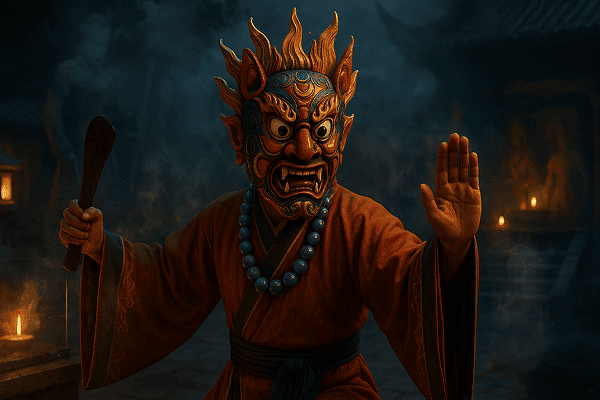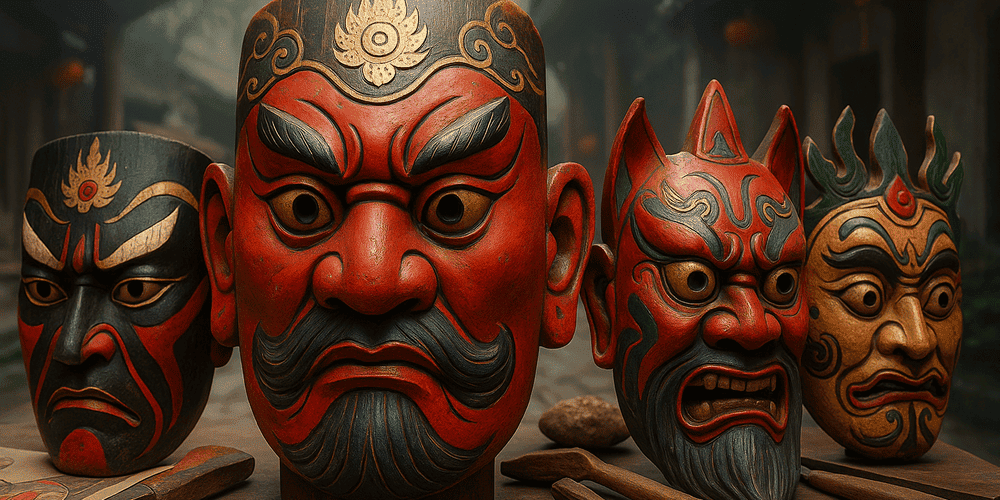Nuo Theatre Masks represent one of the most vibrant and enigmatic mask traditions in China, deeply embedded in the country’s ritualistic and performative heritage. Originating as part of the ancient Nuo opera, these masks are instantly recognizable due to their exaggerated facial features, bold colors, and mystical expressions. Crafted primarily from wood and often adorned with intricate patterns, Nuo Theatre Masks are not merely theatrical props — they are embodiments of spiritual beliefs and ancestral veneration. Predominantly associated with the ethnic minorities of southern China, especially in provinces like Jiangxi, Hunan, Guizhou, and Sichuan, their history traces back over a thousand years, reflecting a profound connection to regional cultures and the early stages of Chinese civilization.
Historical Origins of Nuo Theatre Masks: From Exorcism to Theatrical Art
The genesis of Nuo Theatre Masks lies in the ancient Nuo religion, a shamanistic belief system believed to have originated during the Zhou dynasty (1046–256 BCE). The term “Nuo” comes from the Chinese character “傩” (nuó), which originally meant “to expel” or “to drive away evil spirits.” Historically, Nuo rituals were performed to ward off disease, disasters, and malevolent entities, especially during the annual Lunar New Year celebrations. Over centuries, these exorcistic ceremonies evolved into a form of folk theatre — Nuo opera — where masks played a central role in representing deities, demons, historical heroes, and mythological beings.
The design and function of Nuo Theatre Masks have changed significantly over time. Early versions were simple and utilitarian, serving primarily as protective talismans. As the tradition matured, the masks became more elaborate, reflecting influences from court theatre, Buddhism, and Daoism. Notable historical references to Nuo rituals can be found in ancient texts such as the “Book of Rites” (Liji), and archaeological discoveries of mask fragments in tombs and temples have further illuminated their enduring significance.
Cultural Significance and Symbolism: Nuo Theatre Masks as Spiritual Gateways
Nuo Theatre Masks hold profound symbolic value within the communities that use them. Each mask is believed to embody the spirit of a particular deity or ancestor, serving as a conduit between the human and supernatural realms. The act of donning a Nuo mask during ritual performances is seen as an invocation of divine presence, granting the wearer both protection and authority. This spiritual dimension is reinforced by widespread myths and legends, such as tales of warriors who used the masks to confront demons or stories of ancient shamans who mediated between worlds.

Beyond their spiritual function, Nuo Theatre Masks also play a vital role in expressing social and cultural identity. They are used to convey moral lessons, celebrate historical events, and preserve collective memory. In this way, Nuo masks are both sacred artifacts and living expressions of local heritage, echoing the layered symbolism seen in other global traditions like the Colombina Mask from Venetian masquerades.
Materials and Crafting Techniques: The Artistry Behind Nuo Theatre Masks
The creation of Nuo Theatre Masks is a meticulous process that combines artistry with ritual sanctity. Traditionally, artisans carve the masks from lightweight woods such as willow, camphor, or poplar. The choice of wood is often dictated by local availability and spiritual beliefs, as some types are thought to possess protective qualities. The crafting process involves shaping the wood with chisels and knives, then smoothing and priming the surface for decoration.
Painting is a crucial stage, with each color carrying specific symbolic meanings: red often signifies bravery and loyalty, black represents impartiality, white denotes treachery, and gold is reserved for deities and royalty. Decorative elements may include lacquer, gilding, and inlaid materials, enhancing both the aesthetic appeal and spiritual potency of the mask. Regional styles vary considerably; for example, masks from Jiangxi may feature more angular designs, while those from Guizhou are known for their elaborate ornamentation.
Functions and Uses: The Living Tradition of Nuo Theatre Masks
Throughout history, Nuo Theatre Masks have served multiple functions, primarily in ritual and theatrical contexts. Their earliest use was in exorcistic ceremonies, where masked performers enacted dramas to banish evil spirits and pray for communal well-being. Over time, these rituals gave rise to Nuo opera, a folk theatre genre blending music, dance, and storytelling. Masks also feature prominently in festivals such as the Lantern Festival and local harvest celebrations, where they symbolize prosperity and protection.
In recent decades, the use of Nuo Theatre Masks has adapted to changing cultural landscapes. While traditional rituals remain important in rural areas, the masks are increasingly showcased in museum exhibitions, stage performances, and cultural festivals throughout China and abroad. Contemporary artists and designers draw inspiration from Nuo aesthetics, incorporating mask motifs into fashion, visual art, and even film.
Regional Variations: Diversity Within the Tradition of Nuo Theatre Masks
There is remarkable diversity among Nuo Theatre Masks across different regions of China. In Jiangxi province, for instance, masks tend to be larger and feature stern, commanding visages, reflecting the region’s emphasis on martial deities. In contrast, Guizhou’s Nuo masks are more decorative, with intricate carvings and vibrant palettes. Hunan’s tradition is notable for its use of animal motifs, symbolizing local totems and spiritual protectors.
Comparisons can also be drawn with similar mask traditions worldwide, such as the elaborately decorated Venetian masks used in Italian carnival festivities. This cross-cultural resonance highlights the universal appeal and enduring relevance of mask-making as a form of artistic expression and social communication.
Famous Examples and Collections: Where to Find Nuo Theatre Masks Today
Some of the most celebrated Nuo Theatre Masks are preserved in major museums, such as the National Museum of China in Beijing, the Shanghai Museum, and the Guizhou Provincial Museum. These collections showcase masks ranging from ancient ritual artifacts to contemporary artistic interpretations. Significant archaeological finds, including tomb relics from the Han and Tang dynasties, have provided invaluable insights into the evolution of the tradition.
Private collectors and specialized galleries, including online platforms like toddmasks.com, play a crucial role in preserving and promoting Nuo mask heritage by making authentic pieces accessible to a global audience.
Influence on Art and Culture: Nuo Theatre Masks in the Modern World
The influence of Nuo Theatre Masks extends far beyond their original ritual context. They have inspired generations of artists, writers, and filmmakers, appearing in literature, visual arts, and contemporary stage productions. Elements of Nuo mask design can be seen in modern fashion and graphic design, where bold lines and expressive forms evoke a sense of ancient mystique.

Moreover, the masks contribute to ongoing discussions about cultural preservation and innovation, serving as powerful symbols in the global movement to protect intangible heritage. Their presence in popular media and cultural festivals helps keep the tradition alive, fostering cross-cultural understanding and appreciation.
Contemporary Status and Preservation: Safeguarding Nuo Theatre Masks for the Future
Today, the tradition of Nuo Theatre Masks is maintained by dedicated artisans and cultural institutions. Specialized workshops and schools in regions like Jiangxi and Guizhou train new generations in the art of mask-making, ensuring that traditional techniques are passed down. Government programs and UNESCO initiatives support the documentation and promotion of Nuo opera as intangible cultural heritage.
Modern adaptations, such as collaborative art projects and educational masterclasses, further expand the audience for Nuo masks while respecting their spiritual roots. Outreach programs and museum exhibitions offer hands-on experiences, fostering a deeper appreciation among younger audiences.
Collecting and Acquiring Nuo Theatre Masks: Tips and Ethics
The market for Nuo Theatre Masks has grown steadily, with collectors seeking both antique and contemporary examples. Authentic masks can be acquired from reputable dealers, museum shops, and online galleries like toddmasks.com. Prices vary widely, depending on factors such as age, provenance, artistic quality, and condition.
When purchasing a Nuo Theatre Mask, buyers should carefully assess authenticity, seeking documentation or expert evaluation. It is also essential to consider the ethical implications of acquiring cultural artifacts, ensuring that purchases support local artisans and do not contribute to the illicit trade of heritage objects.
